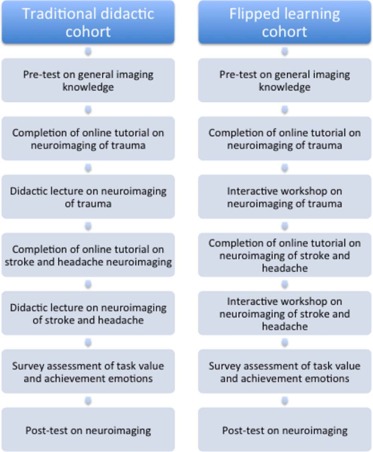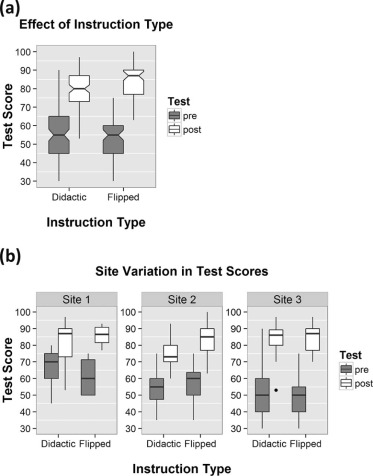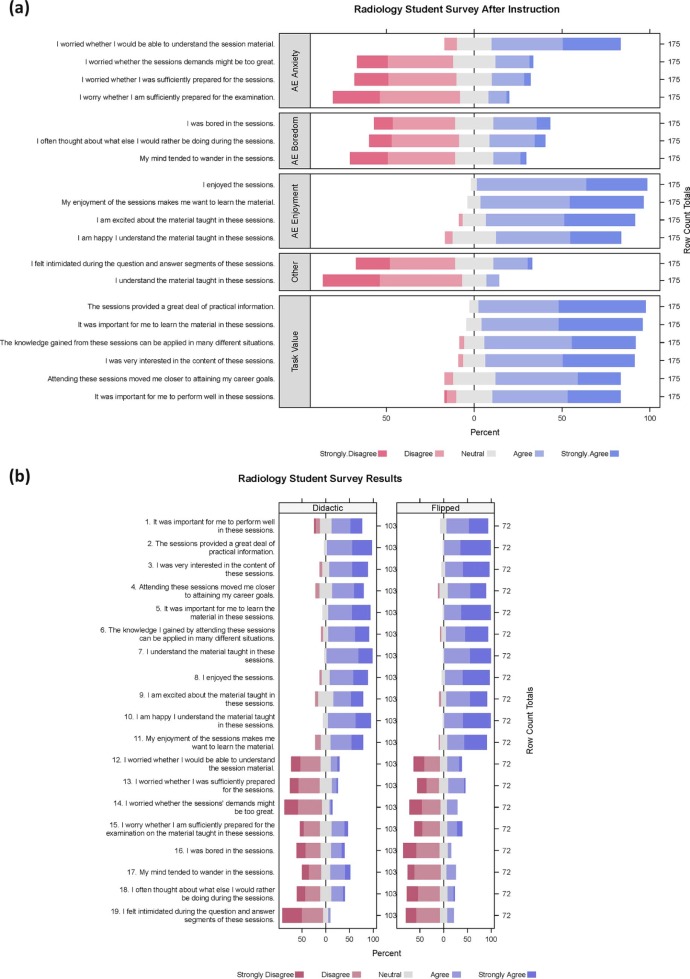Rationale and Objectives
In flipped learning, medical students independently learn facts and concepts outside the classroom, and then participate in interactive classes to learn to apply these facts. Although there are recent calls for medical education reform using flipped learning, little has been published on its effectiveness. Our study compares the effects of flipped learning to traditional didactic instruction on students’ academic achievement, task value, and achievement emotions.
Materials and Methods
At three institutions, we alternated flipped learning with traditional didactic lectures during radiology clerkships, with 175 medical students completing a pretest on general diagnostic imaging knowledge to assess baseline cohort comparability. Following instruction, posttests and survey examinations of task value and achievement emotions were administered. Linear mixed effects analysis was used to examine the relationship between test scores and instruction type. Survey responses were modeled using ordinal category logistic regression. Instructor surveys were also collected.
Results
There were no baseline differences in test scores. Mean posttest minus pretest scores were 10.5% higher in the flipped learning group than in the didactic instruction group ( P = 0.013). Assessment of task value and achievement emotions showed greater task value, increased enjoyment, and decreased boredom with flipped learning (all P < 0.01). All instructors preferred the flipped learning condition.
Conclusions
Flipped learning was associated with increased academic achievement, greater task value, and more positive achievement emotions when compared to traditional didactic instruction. Further investigation of flipped learning methods in radiology education is needed to determine whether flipped learning improves long-term retention of knowledge, academic success, and patient care.
Introduction
Medical students must master an extraordinarily large knowledge base and associated technical vocabulary in a very short time period. To this end, undergraduate radiology education has been largely dominated by didactic teaching methods designed to expeditiously deliver large volumes of information with a minimum student/instructor interaction . However, traditional large group lectures may not be ideal for the facilitation of development of the types of knowledge discovery and problem-solving skills required in radiology and other types of medical practice .
To address this problem, there is growing interest in exploring complementary medical instructional approaches that would more efficiently fill in existing knowledge gaps, foster application of knowledge stores, promote higher order thinking, and better prepare students for the challenges of clinical decision-making encountered in patient care contexts . Although many medical schools have begun to integrate problem- and team-based learning into their curricula, the transition to these interactive learning methods has been slow, and the use of didactic lectures still predominates . It is difficult to assess the learning outcomes associated with the ongoing slow reform in undergraduate medical education over the past decade, because medical educators have historically adopted varying definitions of what constitutes a problem-based learning curriculum, and not all have adopted the criteria advocated by Barrows, who developed the first problem-based learning curriculum at McMasters University . Moreover, estimates of the efficacy of problem-based learning in medical curricula vary .
Get Radiology Tree app to read full this article<
Get Radiology Tree app to read full this article<
Get Radiology Tree app to read full this article<
Get Radiology Tree app to read full this article<
Get Radiology Tree app to read full this article<
Methods
Get Radiology Tree app to read full this article<
Get Radiology Tree app to read full this article<
Get Radiology Tree app to read full this article<
Get Radiology Tree app to read full this article<
Get Radiology Tree app to read full this article<
Get Radiology Tree app to read full this article<
Get Radiology Tree app to read full this article<
Get Radiology Tree app to read full this article<
Get Radiology Tree app to read full this article<
Get Radiology Tree app to read full this article<
Get Radiology Tree app to read full this article<
Get Radiology Tree app to read full this article<
Get Radiology Tree app to read full this article<
Get Radiology Tree app to read full this article<
Get Radiology Tree app to read full this article<
Get Radiology Tree app to read full this article<
Get Radiology Tree app to read full this article<
Data Collection and Analysis
Get Radiology Tree app to read full this article<
Get Radiology Tree app to read full this article<
Get Radiology Tree app to read full this article<
Get Radiology Tree app to read full this article<
Get Radiology Tree app to read full this article<
Results
Get Radiology Tree app to read full this article<
Get Radiology Tree app to read full this article<
Get Radiology Tree app to read full this article<
Table 1
Student Survey Results for Didactic and Flipped Classroom Types
TV-SUM AE-E-SUM AE-A-SUM AE-B-SUM Didactic Strongly Disagree 2 0 70 48 Disagree 23 19 177 91 Neutral 106 88 97 72 Agree 303 194 55 80 Strongly Agree 184 111 13 18 Flipped Strongly Disagree 0 0 57 44 Disagree 2 3 98 108 Neutral 42 28 50 37 Agree 175 118 72 26 Strongly Agree 213 139 11 1 Coefficients Estimate −1.09 −1.15 −0.17 0.90P 0.00040 0.00022 0.59 0.0032
Summed survey responses are grouped by categories.
AE-A, achievement emotions—anxiety; AE-B, achievement emotions—boredom; AE-E, achievement emotions—enjoyment; TV, task value.
Coefficient estimates and their associated P values are shown for the didactic vs flipped condition contrast.
Get Radiology Tree app to read full this article<
Get Radiology Tree app to read full this article<
Table 2
Instructor Survey Responses
Instructor 1 Instructor 2 Instructor 3 Instructor 4 Easy to give a traditional didactic lecture. Disagree Strongly Agree Disagree Agree Easy to give a flipped classroom workshop. Strongly Agree Neutral Agree Agree Students found it easy to learn in a traditional didactic lecture. Disagree Agree Disagree Disagree Students found it easy to learn in a flipped classroom workshop. Agree Strongly agree Agree Agree Satisfied with the instruction I gave in the traditional lecture format. Disagree Agree Strongly disagree Neutral Satisfied with the instruction I gave in the flipped classroom workshop format. Strongly agree Agree Strongly agree Strongly agree The traditional didactic lectures promoted learning. Neutral Neutral Neutral Agree Aspects of the traditional didactic lectures that promoted learning The information was there Instructor determines pace and thus can cover all material. Structured and sequential approach Predictable content. Material presented clearly. Thoroughness and consistency among different groups of students. The flipped classroom workshops promoted learning. Strongly agree Agree Strongly agree Strongly agree Aspects of the flipped classroom workshops that promoted learning. Easier to pay attention. Information seems more easily absorbed. Able to gauge the students’ level of understanding and dispel any misconceptions. Students more comfortable asking questions. Ability to alter teaching when student misconceptions are identified. Students are asked to apply their knowledge. Require higher order cognitive skills. Varied amount of time spent on concepts depending on which concepts the particular group of students found more challenging. The traditional didactic lectures hindered learning. Neutral Strongly disagree Neutral Disagree Aspects of traditional didactic lectures that hindered learning. Mind may wander sometimes Students less engaged. Instructor unable to gauge the students’ depth of knowledge until the end Inability of students to ask questions or clarify understanding during the didactics. Time wasted discussing concepts already mastered, leaving less time to spend on more difficult concepts. The flipped classroom workshops hindered learning. Strongly disagree Neutral Strongly disagree Disagree Aspects of the flipped classroom workshops that hindered learning. If the student did not complete the assigned homework, he/she was lost. Difficult to pace. Variations in knowledge base may have slowed the pace of instruction None Some students feel intimidated by requirement to participate Overall preference using traditional didactic lectures versus flipped classroom workshops for instruction. Greatly prefer flipped classroom workshops Greatly prefer flipped classroom workshops Somewhat prefer flipped classroom workshops Greatly prefer flipped classroom workshops
Get Radiology Tree app to read full this article<
Discussion
Get Radiology Tree app to read full this article<
Get Radiology Tree app to read full this article<
Get Radiology Tree app to read full this article<
Get Radiology Tree app to read full this article<
Get Radiology Tree app to read full this article<
Get Radiology Tree app to read full this article<
Get Radiology Tree app to read full this article<
Get Radiology Tree app to read full this article<
Get Radiology Tree app to read full this article<
Acknowledgments
Get Radiology Tree app to read full this article<
Get Radiology Tree app to read full this article<
Appendix
Get Radiology Tree app to read full this article<
Get Radiology Tree app to read full this article<
Get Radiology Tree app to read full this article<
Get Radiology Tree app to read full this article<
Get Radiology Tree app to read full this article<
Get Radiology Tree app to read full this article<
Get Radiology Tree app to read full this article<
Get Radiology Tree app to read full this article<
Get Radiology Tree app to read full this article<
Get Radiology Tree app to read full this article<
Get Radiology Tree app to read full this article<
Get Radiology Tree app to read full this article<
Get Radiology Tree app to read full this article<
Get Radiology Tree app to read full this article<
Get Radiology Tree app to read full this article<
Get Radiology Tree app to read full this article<
Get Radiology Tree app to read full this article<
Get Radiology Tree app to read full this article<
Get Radiology Tree app to read full this article<
Get Radiology Tree app to read full this article<
Get Radiology Tree app to read full this article<
References
1. Spencer J.A., Jordan R.K.: Learner centred approaches in medical education. BMJ 1999; 318: pp. 1280-1283.
2. Ashley E.A.: Medical education—beyond tomorrow? The new doctor—Asclepiad or Logiatros?. Med Educ 2000; 34: pp. 455-459.
3. Freeman S., Eddy S.L., McDonough M., et. al.: Active learning increases student performance in science, engineering, and mathematics. Proc Natl Acad Sci U S A 2014; 111: pp. 8410-8415.
4. Irby D.M., Cooke M., O’Brien B.C.: Calls for reform of medical education by the Carnegie Foundation for the Advancement of Teaching: 1910 and 2010. Acad Med 2010; 85: pp. 220-227.
5. Frenk J., Chen L., Bhutta Z.A., et. al.: Health professionals for a new century: transforming education to strengthen health systems in an interdependent world. Lancet 2010; 376: pp. 1923-1958.
6. Prober C.G., Khan S.: Medical education reimagined: a call to action. Acad Med 2013; 88: pp. 1407-1410.
7. Neville A.J.: Problem-based learning and medical education forty years on. A review of its effects on knowledge and clinical performance. Med Princ Pract 2009; 18: pp. 1-9.
8. Straus C.M., Webb E.M., Kondo K.L., et. al.: Medical student radiology education: summary and recommendations from a national survey of medical school and radiology department leadership. J Am Coll Radiol 2014; 11: pp. 606-610.
9. Colliver J.A.: Effectiveness of problem-based learning curricula: research and theory. Acad Med 2000; 75: pp. 259-266.
10. Nandi P.L., Chan J.N., Chan C.P., et. al.: Undergraduate medical education: comparison of problem-based learning and conventional teaching. Hong Kong Med J 2000; 6: pp. 301-306.
11. Bergmann J., Overmyer J., Wilie B.: The Flipped Class: Myths vs. Reality. Available at http://www.thedailyriff.com/articles/the-flipped-class-conversation-689.php pp 1-4; Accessed March 29, 2016
12. Davies R.S., Dean D.L., Ball N.: Flipping the classroom and instructional technology integration in a college-level information systems spreadsheet course. Educ Technol Res Dev 2013; 61: pp. 563-580.
13. Foertsch J., Moses G., Strikwerda J., et. al.: Reversing the lecture/homework paradigm using eTEACH Web-based streaming video software. J Eng Educ 2002; 91: pp. 267.
14. Fulton K.: Upside down and inside out: flip your classroom to improve student learning. Learn Lead Technol 2012; 39: pp. 12.
15. Hughes H.: Introduction to flipping the college classroom.2012.pp. 2434-2438. Available at https://www.editlib.org/p/41097/?nl Accessed November 25, 2015
16. Sams A., Bergmann J., Daniels K., et. al.: The Definition of Flipped Learning. Available at http://www.flippedlearning.org/definition Accessed March 29, 2016
17. Sharma N., Lau C.S., Doherty I., et. al.: How we flipped the medical classroom. Med Teach 2015; 37: pp. 327-330.
18. Abeysekera L., Dawson P.: Motivation and cognitive load in the flipped classroom: definition, rationale and a call for research. High Educ Res Dev 2015; 34: pp. 1-14.
19. Strayer J.F.: How learning in an inverted classroom influences cooperation, innovation and task orientation. Learn Environ Res 2012; 15: pp. 171-193.
20. Bergmann J., Sams A.: Flip your classroom: reach every student in every class every day.2012.International Society for Technology in EducationEugene, OR 100 p
21. Deslauriers L., Schelew E., Wieman C.: Improved learning in a large-enrollment physics class. Science 2011; 332: pp. 862-864.
22. Bhattacharyya R.: ‘Flipped’ classroom teaching clicks with B-Schools in India. Available at http://articles.economictimes.indiatimes.com/2013-09-03/news/41726825_1_isb-indian-school-classroom Accessed October 15, 2015
23. Lage M.J., Platt G.J., Treglia M.: Inverting the Classroom: A Gateway to Creating an Inclusive Learning Environment. Journal of Economic Education, pp 31-43; Available at http://www.academia.edu/340051/Inverting_the_Classroom_A_Gateway_to_Creating_An_Inclusive_Learning_Environment Accessed October 15, 2015
24. Available at http://www.albany.edu/news/44951.php Accessed October 15, 2015
25. Available at http://www.uq.edu.au/teach/flipped-classroom/docs/cs-seaboyer.pdf Accessed October 15, 2015
26. Prober C.G., Heath C.: Lecture halls without lectures—a proposal for medical education. N Engl J Med 2012; 366: pp. 1657-1659.
27. Artino A.R., La Rochelle J.S., Durning S.J.: Second-year medical students’ motivational beliefs, emotions, and achievement. Med Educ 2010; 44: pp. 1203-1212.
28. Millis R.M., Dyson S., Cannon D.: Association of classroom participation and examination performance in a first-year medical school course. Adv Physiol Educ 2009; 33: pp. 139-143.
29. Stegers-Jager K.M., Cohen-Schotanus J., Themmen A.P.N.: Motivation, learning strategies, participation and medical school performance. Med Educ 2012; 46: pp. 678-688.
30. Ferguson E., James D., O’Hehir F., et. al.: Pilot study of the roles of personality, references, and personal statements in relation to performance over the five years of a medical degree. BMJ 2003; 326: pp. 429-432.
31. Lewis P.J., Chen J.Y., Lin D.J., et. al.: Radiology ExamWeb: development and implementation of a national web-based examination system for medical students in radiology. Acad Radiol 2013; 20: pp. 290-296.
32. Eccles J.S., Wigfield A.: Motivational beliefs, values, and goals. Annu Rev Psychol 2002; 53: pp. 109-132.
33. Artino A.R., McCoach D.B.: Development and initial validation of the online learning value and self-efficacy scale. J Educ Comput Res 2008; 38: pp. 279-303.
34. Pekrun R.: The control-value theory of achievement emotions: assumptions, corollaries, and implications for educational research and practice. Educ Psychol Rev 2006; 18: pp. 315-341.
35. Pekrun R., Goetz T., Frenzel A.C., et. al.: Measuring emotions in students’ learning and performance: the Achievement Emotions Questionnaire (AEQ). Contemp Educ Psychol 2011; 36: pp. 36-48.
36. Harris P.A., Taylor R., Thielke R., et. al.: Research electronic data capture (REDCap)—a metadata-driven methodology and workflow process for providing translational research informatics support. J Biomed Inform 2009; 42: pp. 377-381.
37. Heiberger R.M., Robbins N.B.: Design of diverging stacked bar charts for Likert scales and other applications. Journal of Statistical Software 2014; 57: pp. 1-32.
38. Berwick D.M., Finkelstein J.A.: Preparing medical students for the continual improvement of health and health care: Abraham Flexner and the new “public interest”. Acad Med 2010; 85: pp. S56-S65.
39. Khanova J., Roth M.T., Rodgers J.E., et. al.: Student experiences across multiple flipped courses in a single curriculum. Med Educ 2015; 49: pp. 1038-1048.
40. Kim M.K., Kim S.M., Khera O., et. al.: The experience of three flipped classrooms in an urban university: an exploration of design principles. Internet High Educ 2014; 22: pp. 37-50.
41. O’Flaherty J., Phillips C.: The use of flipped classrooms in higher education: a scoping review. Internet High Educ 2015; 25: pp. 85-95.
42. Freeman S., O’Connor E., Parks J.W., et. al.: Prescribed active learning increases performance in introductory biology. CBE Life Sci Educ 2007; 6: pp. 132-139.
43. Bransford J.D., Brown A.L., Cocking R.R.: How people learn: brain, mind, experience, and school. Expanded edition.2000.National Academies PressWashington, DC
44. Bonwell C.C., Eison J.A.: Active learning: creating excitement in the classroom. 1991 ASHE-ERIC higher education reports. ERIC clearinghouse on higher education.2016.The George Washington UniversityWashington, DC http://files.eric.ed.gov/fulltext/ED336049.pdf
45. Means B., Toyama Y., Murphy R., et. al.: Evaluation of Evidence-Based Practices in Online Learning: A Meta-Analysis and Review of Online Learning Studies. October 2014; Available at http://www2.ed.gov/rschstat/eval/tech/evidence-based-practices/finalreport.pdf Accessed September 1, 2015
46. Belfi L.M., Bartolotta R.J., Giambrone A.E., et. al.: “Flipping” the introductory clerkship in radiology: impact on medical student performance and perceptions. Acad Radiol 2015; 22: pp. 794-801.
47. Hamdy H., Prasad K., Anderson M.B., et. al.: BEME systematic review: predictive values of measurements obtained in medical schools and future performance in medical practice. Med Teach 2006; 28: pp. 103-116.
48. Artino A.R., Hemmer P.A., Durning S.J.: Using self-regulated learning theory to understand the beliefs, emotions, and behaviors of struggling medical students. Acad Med 2011; 86: pp. S35-S38.
49. Artino A.R., Holmboe E.S., Durning S.J.: Control-value theory: using achievement emotions to improve understanding of motivation, learning, and performance in medical education: AMEE Guide No. 64. Med Teach 2012; 34: pp. e148-e160.
50. Pintrich P.R.: The role of motivation in promoting and sustaining self-regulated learning. Int J Educ Res 1999; 31: pp. 459-470.
51. Bishop J.L., Verleger M.A.: The Flipped Classrom: A Survey of the Research. June, 2013; Available at http://www.studiesuccesho.nl/wp-content/uploads/2014/04/flipped-classroom-artikel.pdf Accessed November 25, 2015


